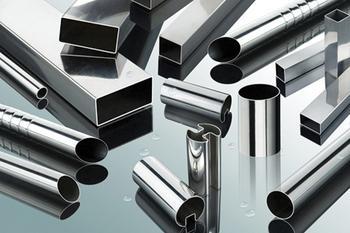 Classification of Stainless Steel Together, stainless steel is often classified according to the state of organization: martensitic steel, ferritic steel, austenitic steel, austenitic-ferritic (duplex) stainless steel, and precipitation hardening stainless steel. In addition, it can be divided into: chromium stainless steel, chromium nickel stainless steel and chromium manganese nitrogen stainless steel.
Classification of Stainless Steel Together, stainless steel is often classified according to the state of organization: martensitic steel, ferritic steel, austenitic steel, austenitic-ferritic (duplex) stainless steel, and precipitation hardening stainless steel. In addition, it can be divided into: chromium stainless steel, chromium nickel stainless steel and chromium manganese nitrogen stainless steel. 1, ferritic stainless steel: chromium containing 12% to 30%. Its corrosion resistance, toughness and weldability increase with the increase of chromium content, chloride stress corrosion resistance is superior to other types of stainless steel, belong to this category are Crl7, Cr17Mo2Ti, Cr25, Cr25Mo3Ti, Cr28 and so on. Ferritic stainless steels have high corrosion resistance and oxidation resistance because of their high chromium content, but they have poor mechanical properties and process properties. They are mostly used in acid-resistant structures that are not stressed and used as anti-oxidation steels. This kind of steel can resist the corrosion of atmosphere, ** and saline solution, and has the characteristics of high temperature anti-oxidation performance, small thermal expansion coefficient, etc. It is used in ** and food factory equipment, and also can make parts working under high temperature, such as gas turbine. Parts and so on.
2, austenitic stainless steel: chromium is greater than 18%, also contains about 8% of nickel and a small amount of molybdenum, titanium, nitrogen and other elements. Good overall performance, resistant to many media corrosion. The commonly used grades of austenitic stainless steels include 1Cr18Ni9 and 0Cr19Ni9. Wc < 0.08% for 0Cr19Ni9 steel and "0" for steel. This type of steel contains a large amount of Ni and Cr, making the steel austenitic at room temperature. This type of steel has good plasticity, toughness, weldability, corrosion resistance and non-magnetic or weak magnetic properties, and has good corrosion resistance in oxidizing and reducing media. It is used to make acid-proof equipment, such as corrosion-resistant containers and equipment. Lining, conveying pipe, resistance to equipment parts, etc., can also be used as the main material of stainless steel watch accessories. Austenitic stainless steels generally use solid solution treatment, that is, the steel is heated to 1050 ~ 1150 °C, and then water-cooled or air-cooled to obtain single-phase austenite.
3, austenitic-ferritic duplex stainless steel: both the advantages of austenitic and ferritic stainless steel, and has superplasticity. Austenite and ferrite are about half of stainless steel. In the case where the C content is low, the Cr content is 18% to 28%, and the Ni content is 3% to 10%. Some steels also contain alloying elements such as Mo, Cu, Si, Nb, Ti, and N. This type of steel combines the characteristics of austenitic and ferritic stainless steels. Compared with ferrite, it has higher plasticity and toughness, no brittleness at room temperature, significantly improved resistance to intergranular corrosion and welding performance, and at the same time retains iron. The 475°C brittleness and high thermal conductivity of the ferritic stainless steel make it superplastic. Compared with austenitic stainless steels, the strength and resistance to intergranular corrosion and chloride stress corrosion resistance are significantly improved. Duplex stainless steel has excellent pitting corrosion resistance and is also a nickel-stainless steel.
4, martensitic stainless steel: high strength, but poor plasticity and weldability. The commonly used grades of martensitic stainless steels are 1Cr13 and 3Cr13. Due to the high carbon content, they have higher strength, hardness and wear resistance, but they are slightly inferior in corrosion resistance. They are used for high mechanical properties and corrosion resistance. General requirements for some parts, such as springs, turbine blades, hydraulic press valves. This kind of steel is used after quenching and tempering. Forging and stamping need to be annealed.
5. Precipitation hardening stainless steel: The matrix is ​​austenite or martensite, and the commonly used grades of precipitation hardening stainless steel are 04Cr13Ni8Mo2Al. It can be treated by precipitation hardening (also known as age hardening) to make it hard (strong) stainless steel.
TS HARDWARE proudly offers a wide variety of stainless steel bolts in several sizes and styles such as hex head, socket style, carriage, and lag bolts. Most of our inventory is available in both type 18-8 and 316 stainless steel bolts. Type 18-8 are standard grade, while 316 is a superior type often referred to as marine-grade steel. It`s known for its durability against harsh conditions that cause rust or corrosion. While 18-8 and 316 stainless steel bolts have a similar strength composition, restaurants, hospitals, and water treatment facilities are best served by marine-grade products. Checkout our unique collection below, and contact us with any questions or concerns. Our highly-trained staff can help you! Can`t find what you`re looking for? Check out our stainless steel screws for more options.
Stainless Steel Bolt,Stainless Steel Eye Bolts,Stainless Steel U Bolts,Stainless Steel Nuts And Bolts
Taizhou TS HARDWARE Co., Ltd , https://www.shuwengroup.com